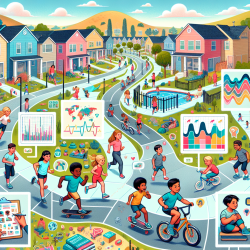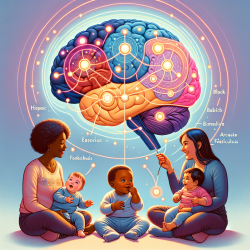Introduction
In the realm of speech-language pathology, we are often focused on enhancing communication skills and cognitive development in children. However, the broader environment in which a child lives can also significantly impact their overall development, including physical activity levels. A recent study, "Changes in Objectively-Determined Walkability and Physical Activity in Adults: A Quasi-Longitudinal Residential Relocation Study," provides valuable insights that can be applied to improve outcomes for children receiving online therapy services, such as those offered by TinyEYE.
The Study at a Glance
This quasi-longitudinal study examined how changes in neighborhood walkability affected physical activity levels among adults. The research involved participants who moved to different neighborhoods with varying levels of walkability. The study categorized participants into three groups: walkability "improvers," "decliners," and "maintainers." The findings revealed that both walkability improvers and decliners were more likely to report changes in their transportation walking and cycling behaviors.
Key Findings and Their Implications for Children
Although the study focused on adults, the implications for children are profound. Here are some key takeaways:
- Increased Physical Activity: Children living in more walkable neighborhoods are likely to engage in more physical activities, such as walking or cycling to school or parks. This increased activity can contribute to better physical health and cognitive development.
- Environmental Influence: The built environment plays a crucial role in shaping children's physical activity levels. Practitioners can encourage families to consider walkability when choosing neighborhoods, as this can have a lasting impact on a child's development.
- Holistic Development: Physical activity is linked to improved concentration, memory, and classroom behavior, all of which are critical for speech and language development. By promoting environments that encourage physical activity, we can support holistic child development.
Practical Applications for Practitioners
As practitioners, we can use these insights to enhance our therapy services:
- Integrate Physical Activity into Therapy: Encourage activities that promote movement and communication, such as interactive games that require physical engagement.
- Educate Families: Share information about the benefits of walkable neighborhoods and how they can support a child's development. Provide resources or tools to help families assess neighborhood walkability.
- Advocate for Environmental Changes: Work with community leaders to promote urban planning policies that enhance neighborhood walkability, thereby supporting children's physical and cognitive development.
Encouraging Further Research
While this study provides valuable insights, further research is needed to explore the direct impact of neighborhood walkability on children's development. Practitioners can play a role by collaborating with researchers to design studies that focus on children and their unique needs.
Conclusion
By understanding the impact of neighborhood walkability on physical activity, practitioners can make informed decisions that enhance therapy outcomes for children. As we continue to explore the connections between environment and development, we can create more effective, holistic approaches to support children's growth.
To read the original research paper, please follow this link: Changes in Objectively-Determined Walkability and Physical Activity in Adults: A Quasi-Longitudinal Residential Relocation Study.










